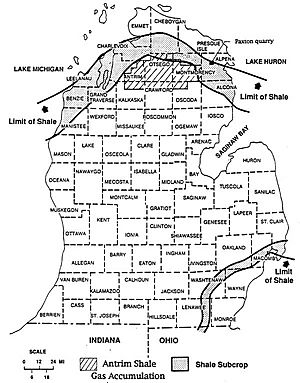Antrim Shale facts for kids
Quick facts for kids Antrim ShaleStratigraphic range: Late Devonian |
|
|---|---|

Antrim Shale outcrop and productive gas area, from Ryder (1996) US Geological Survey.
|
|
| Type | Formation |
| Sub-units | Upper Member, Lachine Member, Paxton Member, and Norwood Member |
| Underlies | Bedford Shale, Ellsworth Shale, and Sunbury Shale |
| Overlies | Squaw Bay Limestone, Traverse Formation and Milwaukee Formation |
| Location | |
| Region | Midwestern United States |
| Country | United States |
| Extent | Indiana, Michigan, Ohio, and Wisconsin |
| Type section | |
| Named for | Antrim County, Michigan |
The Antrim Shale is a special type of rock layer. It formed during the Devonian period, a very long time ago. You can find it mostly in the state of Michigan, USA. It also reaches into Ohio, Indiana, and Wisconsin.
This rock formation is super important because it's a big source of natural gas. This gas is found deep within the northern part of the Michigan area. A scientist named A. C. Lane first described the Antrim Shale in 1901. He named it after Antrim County, Michigan, where he found good examples of the rock.
What is the Antrim Shale Made Of?
The Antrim Shale is a dark rock, usually brown or black. It's a type of shale, which means it's made of very fine mud and clay particles. This shale often looks layered, like thin sheets stacked together. It also contains a lot of organic matter, which comes from ancient plants and animals.
The Antrim Shale can be anywhere from 60 to 220 feet thick. That's like stacking 6 to 22 school buses on top of each other! The amount of organic material in the rock can vary. Sometimes it's just 1%, but other times it can be as much as 20%. In some spots, you might also find gray, chalky shale or limestone. There can even be fine-grained sandstone at the very bottom of the formation.
This rock layer has different names in other places. In Ontario, Canada, it's called the Kettle Point Formation. It's also similar to the New Albany Shale found in the Illinois Basin. The Antrim Shale usually sits below the Bedford Shale. In some areas, it rests on top of the Jordan River Formation or the Thunder Bay Limestone.
How Does the Antrim Shale Produce Natural Gas?
The Antrim Shale is a major source of shale gas. This is a type of natural gas trapped within shale rock. It produces gas across the northern part of Michigan. Most of this gas comes from counties like Antrim, Crawford, Montmorency, Oscoda, and Otsego.
People have been getting gas from the Antrim Shale since the 1940s. However, it became much more popular in the late 1980s. In the 1990s, drilling for gas in the Antrim Shale was very active. Thousands of wells were drilled to get the gas out. So far, over 2.5 trillion cubic feet of gas have been produced. That's from more than 9,000 wells! In 2006 alone, these wells produced about 140 billion cubic feet of gas.
The Antrim Shale seems to be best for gas production at depths of 600 to 2,200 feet. The amount of gas in the rock varies. It can hold from 40 to 100 cubic feet of gas per ton of rock. Wells are usually spaced out over areas from 40 to 160 acres. Unlike some other gas plays, horizontal drilling isn't used much here.
When new wells are drilled, they often pump out a lot of water first. Only after this water is removed does the gas start flowing well. This is similar to how some coalbed methane wells work. What's really interesting about the Antrim Shale is how its gas formed. Most shale gas comes from heat and pressure deep underground. But the gas in the Antrim Shale seems to be biogenic. This means tiny bacteria helped create the gas from the organic material in the rock.
In 2007, the Antrim gas field produced 136 billion cubic feet of gas. This made it the 13th largest source of natural gas in the United States that year.


